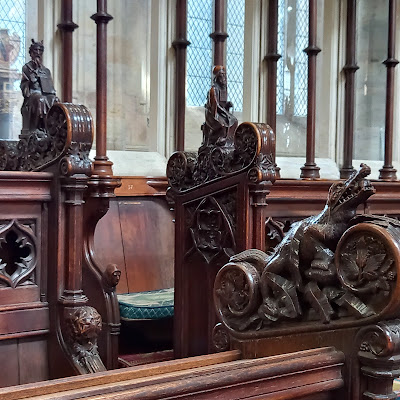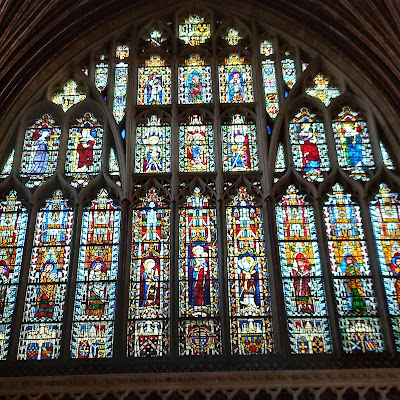Today I set off for a week in the Isles of Scilly. They are an archipelago of islands 28 miles off the Southwest coast of England. I went there in 2019 and enjoyed a quiet holiday with walking as the only activity. I am flying to the main island tomorrow from Exeter as there are no flights from London. Anyway I have never been to Exeter so I decided to stay over and have a look around the city.
It is only a 2 hr train journey from London. As I got off the train there was that familiar feeling of excitement as I arrive somewhere I've never been to before. Exeter is a university city and the streets were full of young people who rightly or wrongly I assumed are students. It is famous for its cathedral so once I'd left my luggage in the hotel I set off to find it. I wasn't disappointed.
The Cathedral was built in the late 13th andu early 14th century.
 |
The round stones of the vault are called 'bosses'.
They are carved with a variety of Gothic images including plants and animals. The most famous is the Becket Boss which depicts the murder of St Thomas Becket in 1170, in Canterbury Cathedral.
Many of the carved angels are playing medieval musical instruments.
 |
| The Martyrs' Pulpit. This was designed by Sir George Gilbert Scott who carried out major restoration of the Cathedral in 1872-77. |
This is the quire. This part of the Cathedral was built between 1290 and 1320. On both sides are the carved choir stalls designed by Scott in the 1870s.
The back row of the stalls contain medieval misericords or mercy seats. These are tip up seats which were used discretely by the clergy during long services. This Elephant one was carved in the 12th century. It is thought it was carved from a drawing owned by Henry III.
 |
On the side walls are numerous memorials.
This monument commemorates Matthew Godwin, Master of the music at Cantebury and Exeter Cathedrals. He died in 1586 at the age of 17.
This window is the most important in the Cathedral as much of the glass is from the 14th century.
Fortunately the medieval glass, misericords and other treasures were removed from the Cathedral during WW2. The Cathedral was hit by a bomb in 1942.
I am so glad I have taken the opportunity to visit Exeter. There is still much more to see in the city which I will share over the next few days.





















Some may suggest your planned offshore trip is a bit silly, but I don't think so. Sorry, I had to do it.
ReplyDeleteIt's interesting to read the memorial to Charles Hawtrey written in old English but quite understandable.
The church has an excellent front presentations and the ceiling of the nave is stunning.
Thank you for sharing your tour of Exeter Cathedral. There are so many treasures there and such artistry and craft. Beautiful.
ReplyDeleteIt is years and years ago when I last visited Exeter and have never been inside the Cathedral. It's beautiful isn't it, especially the fabulous stained glass windows.
ReplyDeleteAll the best Jan